Projections
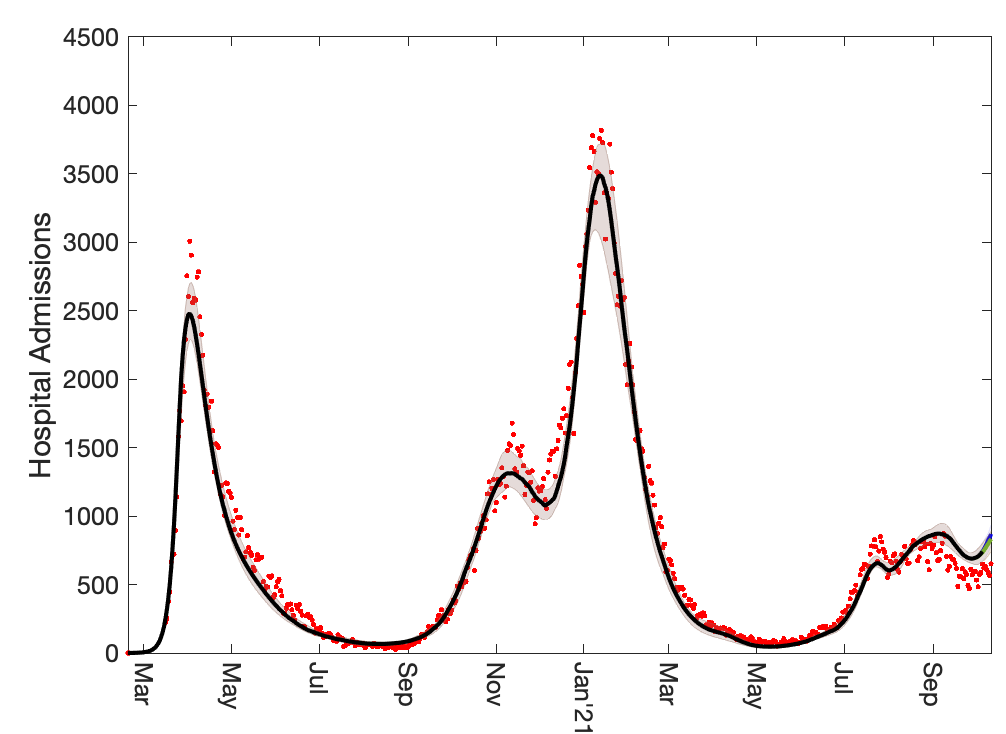 One of the main uses of mathematical models is to project the dynamics into the future - generating short, medium and long-term projections. Warwick has been involved in such projections since early 2020. The Warwick model is a deterministic age-structured model, that has been expanded to include variants, vaccination and waning immunity. The model is matched to data from the seven NHS regions in England, as well as data from Wales, Scotland and Northern Ireland, using a Bayesian approach. We fit primarily to hospital admissions, hospital occupancy, ICU occupancy, deaths and the proportion of tests that are positive; during the invasion of alpha and delta variants we also matched to data on S-gene positivity.
One of the main uses of mathematical models is to project the dynamics into the future - generating short, medium and long-term projections. Warwick has been involved in such projections since early 2020. The Warwick model is a deterministic age-structured model, that has been expanded to include variants, vaccination and waning immunity. The model is matched to data from the seven NHS regions in England, as well as data from Wales, Scotland and Northern Ireland, using a Bayesian approach. We fit primarily to hospital admissions, hospital occupancy, ICU occupancy, deaths and the proportion of tests that are positive; during the invasion of alpha and delta variants we also matched to data on S-gene positivity.
Our publications and pre-prints on projections of COVID are:
|
The model is in regular (weekly) use for R-estimates and medium-term projections, and has been extensively used for the roadmap to relaxation documents throughout 2021: February Roadmap; March Roadmap; May Roadmap; June Roadmap; July Roadmap, October Roadmap. |
Latest Projections for Omicron from 21st December 2021
and later follow-up work from 6th January 2022
Here we present analyses of UK data showing the earliest signatures of the Omicron variant and mathematical modelling that uses the UK data to simulate the potential impact of this variant in the UK. In order to account for the uncertainty in transmission advantage, vaccine escape and severity at the time of writing, we carry out a sensitivity analysis to assess the impact of these variant characteristics on future risk.
|
Keeling, M.J., Dyson, L., Tildesley, M.J. Hill, E.M. & Moore, S. (2022) "Comparison of the 2021 COVID-19 roadmap projections against public health data in England" Nature Communications 13: 4924. https://doi.org/10.1038/s41467-022-31991-0 |
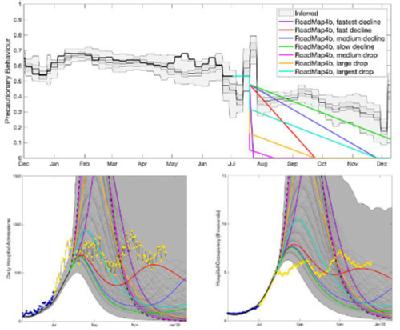 Here we present a retrospective analysis of our six Roadmap documents generated in 2021 to assess the likely impacts of future relaxation steps in England. In each case we directly compare results generated at the time with more recent public health data (primarily hospital admissions, but also hospital occupancy and death) to understand discrepancies and potential improvements. We conclude that, in general, the model projections generated a reliable estimation of medium-term hospital admission trends, with the data points up to September 2021 generally lying within our 95% projection intervals. The greatest uncertainties in the modelled scenarios came from estimates of vaccine efficacy, hampered by the lack of data in the early stages of the Alpha and Delta variant waves, and from assumptions about human behaviour in the face of changing restrictions and changing risk.
Here we present a retrospective analysis of our six Roadmap documents generated in 2021 to assess the likely impacts of future relaxation steps in England. In each case we directly compare results generated at the time with more recent public health data (primarily hospital admissions, but also hospital occupancy and death) to understand discrepancies and potential improvements. We conclude that, in general, the model projections generated a reliable estimation of medium-term hospital admission trends, with the data points up to September 2021 generally lying within our 95% projection intervals. The greatest uncertainties in the modelled scenarios came from estimates of vaccine efficacy, hampered by the lack of data in the early stages of the Alpha and Delta variant waves, and from assumptions about human behaviour in the face of changing restrictions and changing risk.
|
Sachak-Patwa R, Byrne HM, Dyson L, Thompson RN. (2021) The risk of SARS-CoV-2 outbreaks in low prevalence settings following the removal of travel restrictions. Comms. Med., 1:39. DOI: 10.1038/s43856-021-00038-8 |
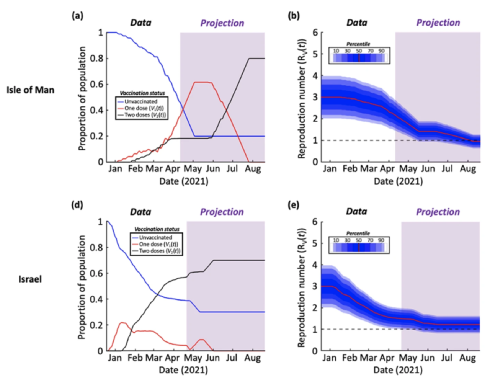 Using SARS-CoV-2 as a case study, we develop a mathematical branching process model to assess the risk that, following the removal of NPIs, cases arriving in low prevalence settings initiate a local outbreak. We consider two locations with low prevalence in which the vaccine rollout has progressed quickly – specifically, the Isle of Man (a British crown dependency in the Irish Sea) and the country of Israel. We show that the outbreak risk is unlikely to be eliminated completely when travel restrictions and other NPIs are removed. This general result is the most important finding of this study, rather than exact quantitative outbreak risk estimates in different locations. It holds even once vaccine programmes are completed. Key factors underlying this result are the potential for transmission even following vaccination, incomplete vaccine uptake, and the recent emergence of SARS-CoV-2 variants with increased transmissibility.
Using SARS-CoV-2 as a case study, we develop a mathematical branching process model to assess the risk that, following the removal of NPIs, cases arriving in low prevalence settings initiate a local outbreak. We consider two locations with low prevalence in which the vaccine rollout has progressed quickly – specifically, the Isle of Man (a British crown dependency in the Irish Sea) and the country of Israel. We show that the outbreak risk is unlikely to be eliminated completely when travel restrictions and other NPIs are removed. This general result is the most important finding of this study, rather than exact quantitative outbreak risk estimates in different locations. It holds even once vaccine programmes are completed. Key factors underlying this result are the potential for transmission even following vaccination, incomplete vaccine uptake, and the recent emergence of SARS-CoV-2 variants with increased transmissibility.
| Keeling, M.J., Dyson, L., Guyver-Fletcher, G., Holmes, A., Semple, M.G., ISASIC4C Investigators, Tildesley, M.J. & Hill, E.M. (2022) "Fitting to the UK COVID-19 outbreak, short-term forecasts and estimating the reproductive number" Stat Methods Med Res. 31(9): 1716-1737. https://doi.org/10.1177/09622802211070257 |
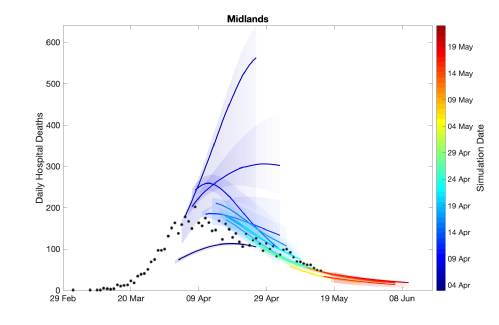
Fitting models to data is key to understanding the dynamics, quantifying the current situation and generated projections of the short, medium or long-term. In this early paper we outline the basic fitting methods used and consider the sensitivity to the way the data is aggregated.
Figure left shows how the initial short-term predictions from the Warwick model have changed over time for deaths in the Midlands (from March to June 2020). While it is clear that early forecasts were extremely pessimistic (as the impact of the lockdown was unknown), later forecasts are in far better agreement with the data and give us considerable certainty on the likely course of the epidemic over the next 2-3 weeks.
| Keeling, M. J., Hill, E., Gorsich, E., Penman, B., Guyver-Fletcher, G., Holmes, A., McKimm, H., Tamborrino, M, Dyson, L., and Tildesley, M. (2020). "Predictions of COVID-19 dynamics in the UK: short-term forecasting and analysis of potential exit strategies" PLoS Comp. Biol. 17(1): e1008619. https://doi.org/10.1371/journal.pcbi.1008619 |
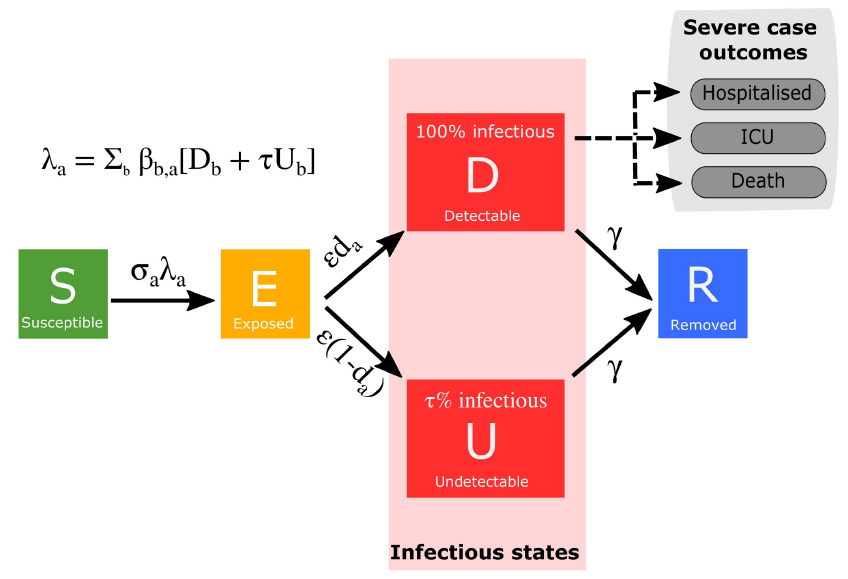 In this very early paper (first published on medRxiv in May 2020) we develop the "Warwick model" for COVID-19, and consider how elements of quarantine and isolation can be included into the fundamental SIR-framework. From an applied perspective, we focus on potential exit strategies, such as different changes to the early lock-down restrictions, age-based easing of the lockdown and basing the lockdown on local ICU capacity. We conclude that any route out of lockdown that does not involve pharmaceutical interventions (such as vaccination) has be be very slow and measured.
In this very early paper (first published on medRxiv in May 2020) we develop the "Warwick model" for COVID-19, and consider how elements of quarantine and isolation can be included into the fundamental SIR-framework. From an applied perspective, we focus on potential exit strategies, such as different changes to the early lock-down restrictions, age-based easing of the lockdown and basing the lockdown on local ICU capacity. We conclude that any route out of lockdown that does not involve pharmaceutical interventions (such as vaccination) has be be very slow and measured.
Figure right. The flow through the multiple sections of the compartmental model, from susceptible to exposed, to either symptomatic or asymptomatic, to ultimately recovered.
Figure below. Examples of epidemic trajectories following different relaxations of lockdown for 2020 and lockdown in 2021. Very rapid relaxation leads to a pronounced early peak, whereas tight controls leads to a later peak in when controls are lifted in 2021.

 See our introductory articles on "How long until it's all over?" and "Winter is coming: Where are we going?" courtesy of our friends at +plus magazine.
See our introductory articles on "How long until it's all over?" and "Winter is coming: Where are we going?" courtesy of our friends at +plus magazine.